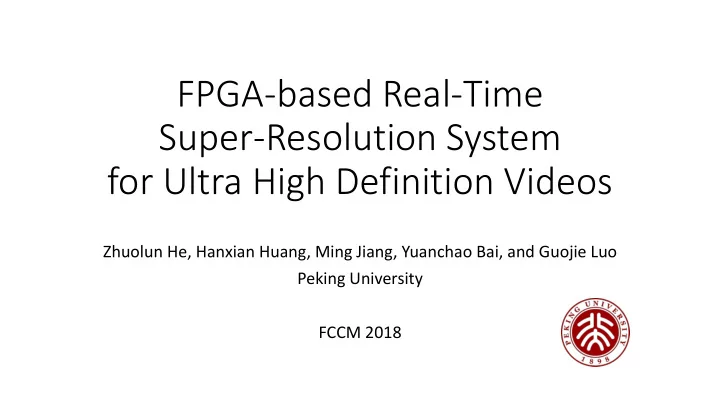

FPGA-based Real-Time Super-Resolution System for Ultra High Definition Videos Zhuolun He, Hanxian Huang, Ming Jiang, Yuanchao Bai, and Guojie Luo Peking University FCCM 2018
Ultra High Definition (UHD) Technology Content? • Limited Creators • High network UHD Television UHD Projector bandwidth cost • Huge storage cost UHD Camera UHD Phone
High-Resolution <---> Low-Resolution Desired HR Image 𝒀 Super-Resolution Blur Down-Sampling Noise 𝑜 Observed LR Image 𝒁
Spectrum of Super Resolution Methods Complicated Simple Interpolation Model-based Example-based • Fast • Interpretable • State-of-the-art quality • Easy to implement • High complexity • High complexity • Blurry results • Assumed known • Training data needed blur kernel/noise
Model-based Method is also Compute-Intensive Desired HR Image 𝒀 Iteration 1 Iteration 2 X Super-Resolution Blur … Down-Sampling Noise 𝑜 Model-based methods may not be needed • The computation also has a layered structure Observed LR Image 𝒁 • We can use a neural network to approximate
Total Variation Distribution Fact: Blocks contain DIFFERENT amount of information (NOT equally important) Insight: Use DIFFERENT upscaling methods for different blocks
A Hybrid Algorithm INPUT: LR Image 𝒁 1. Crop 𝒁 into sub-images { 𝒛 } 2.1. 𝒚 <- Upscale( 𝒛 ) IF 𝑵 𝒚 > 𝑼 2.2. ELSE 𝒚 <- CheapUpscale( 𝒛 ) 3. Mosaic 𝒀 with {𝒚} OUTPUT: HR Image 𝒀 M: Total Variation (TV) Upscale: FSRCNN-s CheapUpscale: Intepolation
Overall System Pipelined Neural Network Dispatcher Deconv(32, 9, 1) Conv(1, 5, 32) Conv(32, 1, 5) Conv(5, 3, 5) Conv(5, 1, 32) High-Res Low-Res Shrinking Feature Extration Mapping Expanding Deconvolution Image Image Interpolator Accelerator
Stencil Access of TV Computation (𝛼𝑦) offset = 𝑏𝑐𝑡(𝑦 right − 𝑦 offset ) + 𝑏𝑐𝑡(𝑦 down − 𝑦 offset ) 𝑂 width 0 height x[offset] x[offset] x[right] x[right] …… …… f3 f3 f2 f2 x[down] x[down] f1 f1 𝑂
Micro-architecture for Stencil Computation Buffering System for array x buffer1( 𝑂 -1) s1 s2 buffer2(1) s3 x[i][j] … x[i-1][j+2] x[i-1][j+1] f1 f2 f3 x[i-1][j+1] x[i][j] x[i-1][j] (x[right]) (x[down]) (x[offset]) Computation Kernel (𝛼𝑦) 𝑗,𝑘
Convolutional Neural Network Pipelined Neural Network Conv(1, 5, 32) Conv(32, 1, 5) Deconv(32, 9, 1) Conv(5, 3, 5) Conv(5, 1, 32) Expanding Feature Extraction Shrinking Mapping Deconvolution
Convolution 𝑂 i 𝑂 i+1 sliding window(s) 1 f i Conv ( c i , f i , n i ) n i c i Output Input Compute
Deconvolution 𝑂 i 𝑂 i+1 s sliding window(s) f i Deconv ( c i , f i , n i ) c i n i Input Compute Output
Pipeline Balancing Ideal Alloc. 𝒅 𝒋 𝒈 𝒋 𝒐 𝒋 𝑶 𝒋 Layer #Mult. Ideal II Alloc. II #DSP #DSP Extraction 1 5 32 36 819200 201 4076 200 4096 Shrinking 32 1 5 32 163840 40 4096 32 4096 Mapping 5 3 5 32 202500 50 4050 45 4500 Expanding 5 1 32 30 144000 35 4115 32 4500 Deconvolution 32 9 1 30 2332800 573 4072 519 4500 Overall - - - - 3662340 899 4115 828 4500 Available (ZC706) - - - - - 900 - 900 -
Sub-image Size • Padding #𝐷𝑝𝑜𝑤 • 𝑂 𝑗 ≡ 𝑙 + 𝑔 𝑗 − 1 𝑗 • If sub-image size too small • Large border-to-block ratio • Limited by memory bandwidth • If sub-image size too large • Large feature maps • Limited by on-chip BRAM capacity
Sub-image Size vs. Performance vs. #mult. PSNR SSIM Multiplications 39,0 0,940 9,50E+09 38,5 0,935 PSNR (dB) 38,0 9,00E+09 0,930 SSIM 37,5 0,925 37,0 8,50E+09 0,920 36,5 36,0 0,915 8,00E+09 10 20 30 40 50 10 20 30 40 50 Block Size Block Size
Overall Comparisons • Compared six configurations No. Preprocessing Upscaling #Mult. PSNR(dB) SSIM 1 None Interpolation 6.6*10^7 35.51 0.9138 >100x +3.04dB 2 None Neural Network 8.2*10^9 38.55 0.9421 No Performance Loss 3 Blocking Interpolation 6.6*10^7 35.51 0.9138 4 Blocking Neural Network 8.4*10^9 38.55 0.9420 5 Blocking Mixed-Random 2.2*10^9 36.10 0.9211 +1.26dB 6 Blocking Mixed-TV 2.2*10^9 37.36 0.9287 -75% -1.19dB
Example Outputs Configuration 5 Configuration 1 Configuration 3 Blocking/Mixed-Random None/Interpolation Blocking/Interpolation Configuration 6 Configuration 2 Configuration 4 Blocking/Mixed-TV None/Neural Network Blocking/Neural Network
Summary Flow • Crop each frame into blocks • Suitable for low-level (pixel-level) tasks • GOOD: on-chip buffer friendly • BAD: Computation overheads • Dispatch blocks according to TV value • Micro-architecture for buffering system • Fully-pipelined CNN for upscaling • Sliding window for convolution/deconvolultion • Pipeline balancing • Performance • Full-HD (1920x1080) -> Ultra-HD (3940x2160): 31.7fps
Thank you!
TV Threshold vs. Performance vs. #mult. PSNR SSIM Multiplications 38,5 0,945 2,5E+10 38,0 0,940 2,0E+10 37,5 0,935 PSNR (dB) 1,5E+10 37,0 0,930 SSIM 36,5 0,925 1,0E+10 36,0 0,920 5,0E+09 35,5 0,915 35,0 0,910 0,0E+00 30 40 50 60 70 30 40 50 60 70 TV Threshold TV Threshold
Resource Utilizations Component BRAM DSP FF LUT Dispatcher 1 2 618 1138 Neural Network 178 844 63149 98439 Interpolator 0 10 1414 3076 Total 327 858 66261 103714 Available 1090 900 437200 218600 Utilization (%) 30 95 15 47
Recommend
More recommend